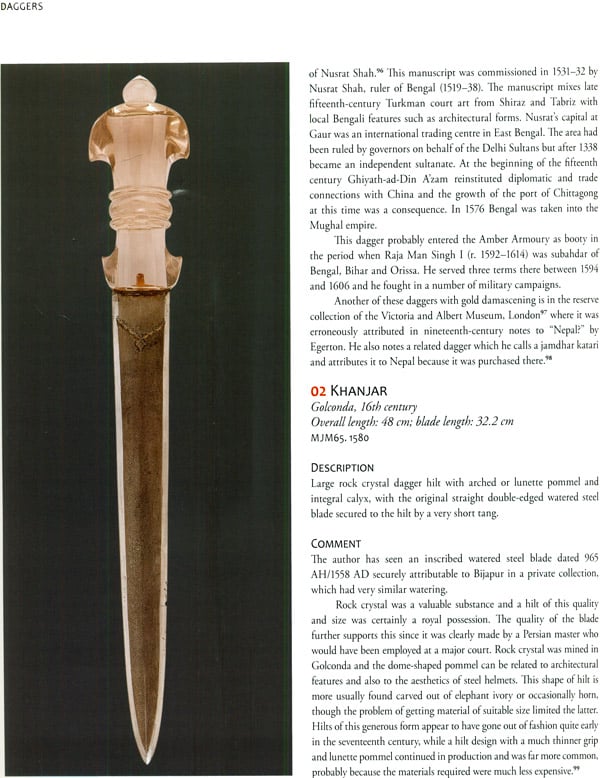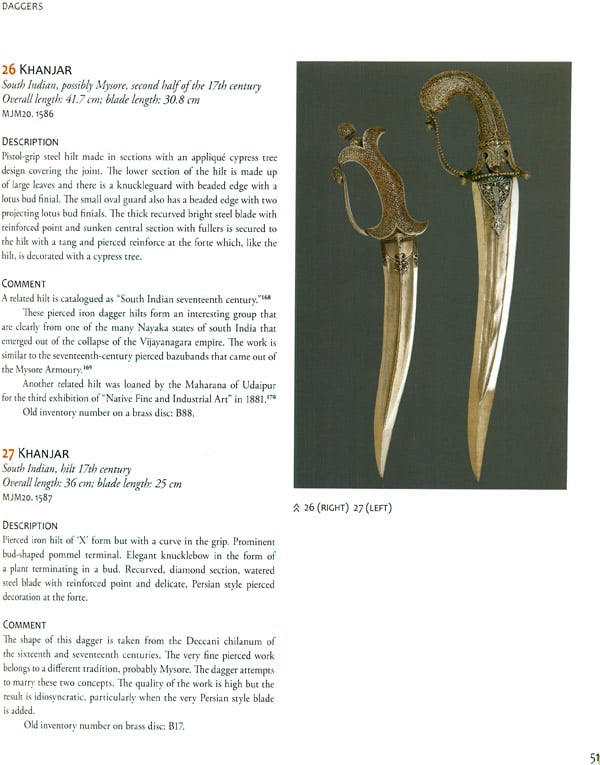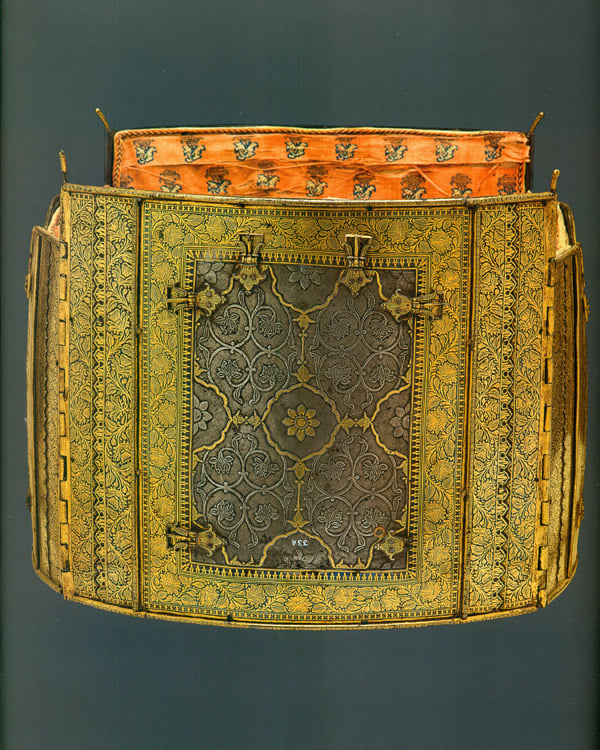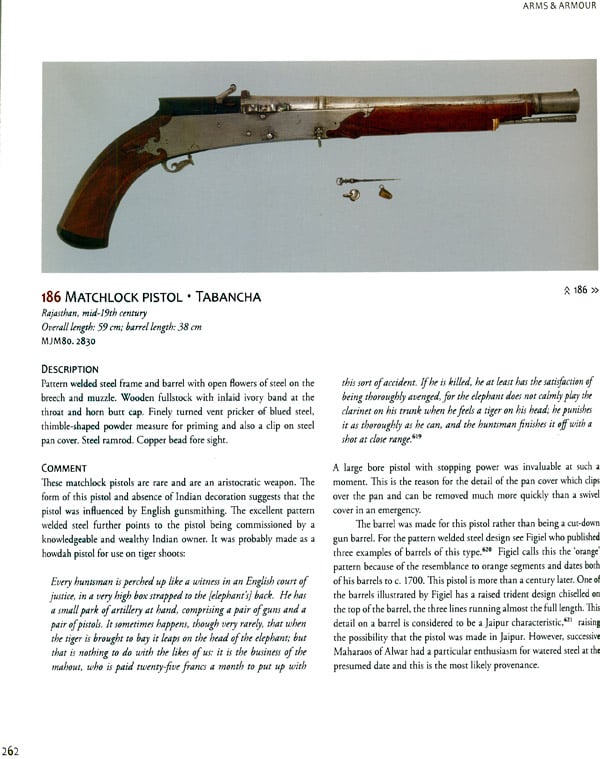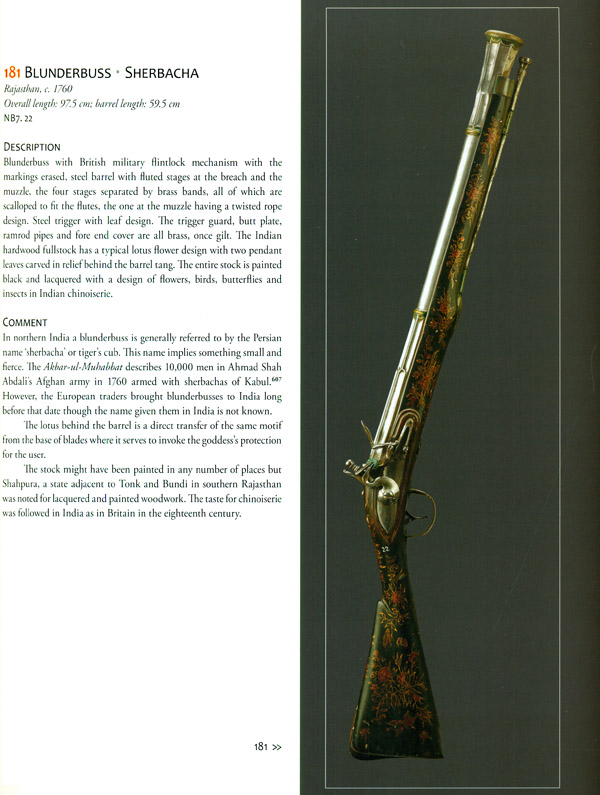
Arms and Armour: At The Jaipur Court (The Royal Collection)
Book Specification
| Item Code: | NAK645 |
| Author: | Robert Elgood |
| Publisher: | Niyogi Books |
| Language: | English |
| Edition: | 2015 |
| ISBN: | 9789383098774 |
| Pages: | 296 (Throughout Color Illustrations) |
| Cover: | Hardcover |
| Other Details | 12.0 inch x 9.5 inch |
| Weight | 1.90 kg |
Book Description
About the Book
This book is one in a series illustrating the collections of the Maharaja Sawai Man Singh II Museum. City Palace. Jaipur, Others in the series are Festivals It the Jaipur Court by Vibhuti Sachdev and Costumes and Textiles at the Jaipur Court by Rahul Jain.
The author Dr. Robert Elgood is a much-published expert in the field of Arms and Armour. He has selected 186 of the most interesting arms in the Jaipur royal palace and discusses them as weapons in their social and historical context. 'The book breaks new ground in Indian arms scholarship and is also a very readable account that takes in Rajput. Mughal and British Indian history. anthropology and art history .. , he objects arc stunning: swords belonging to the Mughal Emperors Jahangir. Shah jahan and Aurangzeb; wonderful court daggers with hilts of carved rock crystal, jade, ivory and gilt steel; ferocious tribal arms; some remarkable historic firearms and beautiful painted shields. some of which were decorar in Japan for the Mughal court. "There is even a device for extracting arrows from wounds with toe-curling ancient medical remedies. Most of these arms are from the reserve collections and published for the first time 'l he book will be essential for all museum curators. dealers and collectors working in this field.
About the Author
Dr. Robert Elgood has a BA in Islamic History from the School of Oriental and African Studies (SOAS), London University; and a D. Phil. From Oxford University in Indian Anthropology. He was consultant in Indian and Islamic arms at Sotheby’s London in the 1980s and Research Fellow, Eastern European, Islamic and Asian Arms and Armour at the Wallace Collection 2006-2012. He is a Fellow of the Society of Antiquaries and a Fellow of the Royal Asiatic Society.
He is a Guest Scholar at the Islamic Museum, Doha, in Oman and Kuwait and also lectures at the SOAS and the Victoria and Albert Museum in London, and the Aga Khan University, The French Institute, Cairo. He is currently working as a consultant for the Al Sabah Collection, Kuwait.
Foreword
In 1957 my grandfather H.H. Maharaja Sawai Man Singhji opened the Museum to the public in part of City Palace and in 1959 he gave it a very large number of arms from his personal collection. At that time this was a very remarkable and radical action but he cared deeply about Rajput history and the role of the Kachhwahas in Indian history and he wanted to preserve as much as possible for the future. Rajput princesses were traditionally taught by their fathers about weapons, the state armoury and the heroic history of their clan. So I introduce this excellent catalogue of selected pieces from the City Palace Armoury with great pride in the knowledge that my grandfather would have Strongly approved of this book. Dr. Elgood, a noted expert on the subject, has described the arms and their history and at the same time has brought the subject to life in an interesting and readable manner. The arms collection in the City Palace Museum has always been important to the Kachhwahas and this is a book that will appeal to scholars and to the general reader alike. I am grateful to Dr. Elgood for his scholarship and dedication.
The arms in the Museum are of national importance. It is a large collection and at present only a part of it is on display to the public but work has started to create a new, modern display in a new location and this catalogue is part of this initiative. It is also part of a series of books by international experts about selected objects in the Museum.
Introduction
The Kachhwaha Rajputs of Amber proudly claim descent from Surya the Sun God and their line descends through Kusha, one of the sons of Rama, King of Ayodhya. In due course they moved from Ayodhya to Gwalior, leaving the latter in the eleventh century for eastern Rajasthan where they established the state of Dhundhar with a capital at Dausa. About 1037 they captured the ancient town of Amber from the Minas.' The Greek writer Ptolemy mentioned Amber in the second century AD. By agreement the defeated Minas became part of the Kachhwaha state and were entrusted with the protection of the ruler and state treasures. The Minas of Kali-Kho were also given the privilege during each coronation of applying the raj tilak" to the forehead of the Kachhwaha ruler, the blood being taken from a pinprick to the big roe of the Mina chief. This practice continued till the seventeenth century when the Mughal emperors took over the role of personally appointing each new raja.
The small kingdom of Amber was a feudatory of Marwar until the sixteenth century. In 1562 Raja Bharmal (r. 1548-74) sought a meeting at Sanganer with the Mughal Emperor Akbar who was on his way to Ajmer. Bharmal needed political and military support in dealing with divided clan loyalties at Amber and shrewdly entered into alliance with the Mughals, strengthening the relationship by giving his eldest daughter Harkha Bhai? in 'marriage to the Emperor Akbar. The marriage ceremony included full Hindu rituals after which Bharmal proceeded to the imperial court at Agra accompanied by an entourage that included his sons Bhagwant Das and Jagannath and 12 year-old grandson, Man Singh. Raja Bharmal and the Amber princes were given important posts in the Mughal army with mansab rank. Thus began a mutually beneficial relationship, born out of political need on both sides. The Rajput alliance came to be one of the cornerstones of Mughal polity, with the Rajputs forming a powerful counter balance to the ambitions of other ethnic groups at the Mughal court. It placed the Kachhwahas at the heart of the Mughal empire. Akbar's son by Harkha Bai was the future Emperor Jahangir. Bhagwant Das's daughter married Jahangir in 1585 and gave birth to Prince Khurram, the future Shah Jahan in 1586. Four generations served the Mughals with particular brilliance: Bhagwant Das, Man Singh, Mirza Raja Jai Singh and Sawai Jai Singh. The bravery, diplomatic and administrative abilities of the Kachhwaha rajas brought wealth and honours to Amber.
After his alliance with Amber, Akbar tackled Rajputana with a combination of war and treaty, ably assisted by the rulers of Amber. The subjugation of the principal forts of Chittor in 1558 and Ranthambhor in 1559 followed the conquest of Nagaur, Ajmer and Merta, Raja Man Singh of Amber (1589-1614) was made the governor of several troublesome Mughal provinces, namely Kabul, Bihar and Bengal. At the Kachhwaha capital of Amber there are palaces, temples, the Maota Sagar lake and a town, all surrounded by protective walls. Early in his reign Raja Man Singh constructed a new palace decorated in an early Rajput style of wall painting. He also built temples as well as two mosques as tokens of gratitude to the Emperor.
Above the walls of Amber on top of the hill sits the fortress of Jaigarh. The exalted position of the Kachhwahas in the very sophisticated Mughal court brought them into contact not only with the best artists of the Indo-Persian world but also with the best craftsmen and the most up-to-date military technology available to the Mughals. In the early part of Akbar's reign the very best technology was in western India where the Portuguese, Turks, Persians and Mamluks all contributed to military development and trade. Emperor Akbar understood this and his whole strategy was intended to control and dominate Rajasthan in order to enable his conquest of the western Indian states that drew their wealth from Indian Ocean trade.
The earliest cannon in the possession of the Kachhwahas were probably gifts from the Mughals. The department of artillery that was run by the daroga-i-topkhana was given the Turkish name Mahakma Topkhana. It is believed that Man Singh learnt cannon founding while serving the Mughals in Kabul. He brought the information to Amber and his father, Bhagwant Das, then ruler, built a gun foundry in 1584 in Jaigarh Fort to the annoyance of the Mughals who wished to keep this technology secret. The earliest cannon found inside the fort dates from 1587. The gun foundry is remarkably intact. It consists of a furnace and a drilling complex and covers an area of 162 by 57 feet. Jaivana, the biggest cannon on wheels in the world, was constructed at the foundry in 1720. Its barrel is 20 feet long and weighs about 50 tons. The records give us the names of some of the other cannon: topsrowar; fateh-daulat, sawatkhani; mangarh; pomel; harphu; ramchangi; kishan ban; dasmukhi; jaswal; ramban; kisvanva; bijay-mukhi: bopatri.? The expert gunfounder Imam Kamal was employed by the Jaipur karkhana to manufacture cannon" in the eighteenth century.
There are four gods that legitimise and protect the Kachhwahas. The earliest icon was Jamvai Mataji from the eleventh century; Sitaramji was brought by the Ramanandis of Galta in the sixteenth century; the Govind Dev icon reached Jaipur from Vrindaban after a journey of a few decades and in 1739 was installed in the Jaipur City Palace temple. From 1740 all holders of jagirs and ijaras? had to share the financial burden of maintaining these gods. Jai Singh 11 revived vedic rituals of kingship and the performance of the horse sacrifice." In 1604 Raja Man Singh returned home to Amber from his campaign in Bengal with an idol of the goddess Shila Mara. He created a temple within his palace for the goddess, and it became the custom for the ruler and his subjects to obtain the blessings of Shila Mara before embarking on matters of consequence, particularly military campaigns. It also became the norm for successive maharajas to ride at the head of their troops to the goddess at Amber on Dussehra,? in a later period the Sawai Man Singh Guards placed the standard of this elite force before Shila Mata.
Man Singh's successor, Raja Bhao Singh (r. 1614-21) was sufficiently integrated into the Mughal court to have an atelier in Amber that produced paintings that were remarkably akin to the Mughal idiom. The same convergence of style probably applied to arms and their decoration. Mughal court miniatures show the Rajput adoption of the asa shamshir and a curved sabre at the waist. However, in personal portraits the Rajputs maintained their traditional arms: broadsword blades with substantial rulwar hilts - the pommel disk considerably larger than the usual Mughal type - and very long katars.
Jai Singh was born in 1611 and ascended the throne of Amber at the age of ten. His tenure spans Above: Indian man seated wearing the reign of the Mughal Emperor Shah Jahan and the early part of Aurangzeb's rule. He was present military uniform, 19th century photgraph at most of the great Mughal campaigns of his lifetime. When Shah Jahan came to the throne in 1627 from the Palace archive (Wet collodion the Amber Rajputs were part of a Mughal army stationed in the Deccan commanded by Khan Jahan glass plate negative, digitally reproduced, Lodi who, with his Afghan followers, took advantage of the power hiatus to revolt against the centre. MSMS If M 2012.04.0040-0006).
Jai Singh managed to extract his troops and retired north, and was later part of the Mughal army that Below: Maharaja Sawai Madho Singh 11 put down the revolt. In 1636 Jai Singh played a major role in another Deccan campaign, as a result of (1880-1922).
which he was accorded many marks of favour in March 1637, including land, khilat from the Emperor's own wardrobe, a jewelled dagger with a phulkatara and a Qipchaq horse'? from the Emperor's own stable with a gold saddle." In 1638, he accepted the surrender of Kandahar from the Persian commander Ali Mardan Khan Kandahar on behalf of Shah Jahan. The trust and regard that the Emperor had for Jai Singh is indicated by his being sent with an army of 50,000 to secure this important strategic town. For this service he was granted the title of Mirza Raja, as once his great-grandfather had been. In 1647 he was part of Shah Jahan's unsuccessful invasion of Badakshan in Central Asia. In 1641 Jai Singh defeated the rebel ruler Jagat Singh of Pathania in Himachal Pradesh. After the Persians recaptured Kandahar in 1649, Jai Singh accompanied Prince Aurangze in the furile campaign to recover the fort from 1649-52. In 1653 he accompanied Shah Jahan's eldest so Dara Shukoh who led a third unsuccessful campaign against Kandahar. Despite covering the retreat with ski Jai Singh was not honoured for his role. Instead he suffered from the enmity of Prince Dara Shukoh who! handling of the campaign had been inept.
Shah Jahan became ill and incapacitated in 1657 and his sons fought for the throne. Being loyal to Sha Jahan, Jai Singh felt obliged to support the Emperor's chosen heir and eldest son, Prince Dara Shukoh. The prince sent him with his son, Sulaiman and the Afghan general Dilir Khan against his brother Shuja in Beng: who they defeated at the battle of Bahadurpur. However, by then Aurangzeb had won the battles of Dharm: and Samugarh and had captured Agra and Shah Jahan. Aurangzeb needed the support of the Rajputs to keep his throne and he pardoned Jai Singh and the ruler of Marwar, Jaswant Singh, both of whom had fought against him. However, Dara Shukoh was captured and executed in 1659.
In 1664 Aurangzeb appointed Jai Singh, by then aged 55, to lead a Mughal army in western Maharashtr against the Maratha hero Shivaji, who had defeated all previous Mughal armies. A year earlier, the Emperor maternal uncle, Shaista Khan, had been humiliated by Shivaji. With great daring Shivaji and a small force of Marathas infiltrated the Mughal encampment at night. They entered Shaista Khan's personal quarters an killed his son, several wives and wounded the general. Shivaji's next exploit was to sack the rich and important town of Sur at. In slightly less than a year Jai Singh forced Shivaji to sue for peace. The Mararha king was force to surrender 23 forts and land producing revenue of four lakhs, and pledge service and loyalty to the Emperor In return he was allowed to keep 12 forts and revenue worth one lakh. Aurangzeb rewarded Jai Singh with robe of honour, a personal sword decorated with enamel, an elephant with a silver howdah and cloth-of-go] canopy and made him commander of7,000 troops, the highest rank available in the Mughal stare."
Jai Singh's last campaign was not so fortunate. The neutralising of Shivaji enabled Aurangzeb to turn his attention to one of the great objectives of seventeenth-century Mughal policy, the defeat and annexation to Bijapur. Jai Singh was despatched at the head of a Mughal army of 40,000, with Shivaji's cavalry and infantry as an auxiliary force. He reached within 12 miles of Bijapur before scorched earth tactics forced his hungry army to retreat north. Imperial displeasure followed, perhaps an opportune move by Aurangzeb to contra his Hindu subject. Amber also faced financial ruin for a time as Jai Singh had spent ten million rupees 0 his own money 011 the campaign; he had been given only three by the imperial treasury. Jai Singh's previous successes and service were now ignored and it is thought that his unexpected death in 1667 was due to poison administered on the orders of the Emperor.
His son Ram Singh succeeded Jai Singh. Emperor Aurangzeb presented the newly anointed Raja Ram Singh with an elephant (price Rs 12,000), a horse (price Rs 5,000), a jewelled sword (price Rs 3,000), a second sword (price Rs 2,000), and a robe of honour.
A seventeenth-century khanda-hillted Deccan sword with a broad forward curved blade (formerly worn by Raja Bisham Singh of Dhundhar) was presented by the Maharaja of Jaipur to the Prince of Wales during the latter's Indian tour in 1875-76.14 The wooden scabbard is covered with green velvet and has gold mounts enamelled with red flowers on a white ground. The attribution is taken from a secondary reference to the Jaipur inventory.
Maharaja Sawai Jai Singh II (r, 1699-1743) was one of the greatest figures of his time with interests in science, the arts, architecture and social reform. He founded the new capital of Jai Nagar or Jaipur in 1727. Across from Jaigarh and above the city is the Nahargarh or Tiger Fort, much of which was also built by Jai Singh. It was originally known as Sudarshangarh. The Silehkhana or Armoury moved to Jaipur from Amber in 1727. It was the responsibility of a department called the Mahakarna Silehkhana. The Vijaygarh building was used as an armoury and was one of the most important of the 36 karkhanas.P The details are recorded in a bahi which has entries such as the one informing us that Jaipur had 461 swords in the Hazuri Silehkhana in 1815 VS/AD 1758.16
Despite the strong influence of the Mughals and Mughal culture on the Rajput courts in the sixteenth and seventeenth centuries it would be quite wrong to see Jaipuri art as merely inferior Mughal art. Most art is a synthesis. The Mughals absorbed Rajput art and amalgamated it with their own central Asian Persian cultural tradition. They gave back with interest to a society that had never abandoned its rich folk tradition and maintained both traditions. The decline of the Mughals in the eighteenth century enabled provincial courts to manifest a revived sense of their local Hindu identity while retaining much Mughal sophistication. The decline of Mughal power resulted in ruler's being able to spend more time in their own capitals but even Jaipur was unable to ignore the rise of the Marathas who were filling the political and military vacuum left by the Mughals. As a result provincial courts in the eighteenth century felt free to manifest a revived sense of their local Hindu identity while retaining much of the sophistication learnt under the Mughals. In this they were very influenced by painters and craftsmen trained at the Mughal court who first dispersed during the time of Aurangzeb, as the Emperor's interest in the arts did not match the enthusiasm of his forebears. Moreover, they were loath to linger in eighteenth-century Delhi as the great Mughal city was overwhelmed by a series of avaricious freebooters, beginning with the Marathas in 1737, the Persian Nadir Shah in 1739, and by the Afghan ruler Ahmad Shah Durrani in 1757. Puppet emperors were repeatedly installed as the Marathas and Afghans fought for control over Delhi. Eventually the British defeated the Marathas at the battle of Delhi in 1803.
Rajput art therefore follows two distinct traditions that influence each other, a court art that draws on the art of the Mughals but is expressed increasingly in Hindu terms; and an exuberant, vibrant, popular Rajput tradition. This reaffirmation of the identity of the Kachhwahas after years of being under the shadow of the Mughals is reflected in all aspects of their art including arms and armour from the eighteenth century. For example, just as Jaipur painting in the early eighteenth century was faithful to Mughal realism and gradually moved to heavily stylised portraits covered in thick gold, so too did the gold decoration increase on the arms of the Jaipur rulers. The gold covered dagger I? in the Jaipur museum made for Maharaja Sawai Pratap Singh (r.1778-1803) is a good example of this later style. Another is the Maharaja's gold covered portrait (c. 1780) in the British Museum. Arms decoration reflected status and was an obvious means of expressing wealth and power.
Contents
| FOREWORD BY PRINCESS DIYA KUMARI OF JAIPUR | 6 |
| ACKNOWLEDGEMENTS | 8 |
| CATALOGUING TERMS | 9 |
| INTRODUCTION | 10 |
| Daggers | 26 |
| Katars | 78 |
| Swords | 100 |
| Children's Arms | 148 |
| Lances, Spears and Shields | 152 |
| Armour | 178 |
| Axes, Ankus, Chhadi and Maces | 195 |
| Bows and Arrows | 218 |
| Accoutrements | 228 |
| Guns and Pistols | 244 |
| MAP | 264 |
| THE RULERS OF AMBER – JAIPUR | 265 |
| ENDNOTES | 266 |
| GLOSSARY | 278 |
| BIBLIOGRAPHY | 282 |
| INDEX | 294 |

